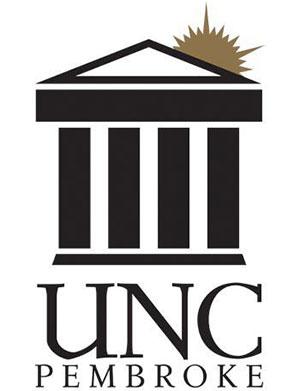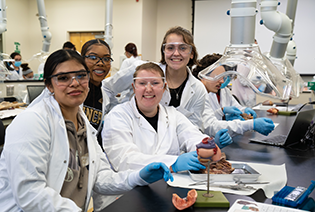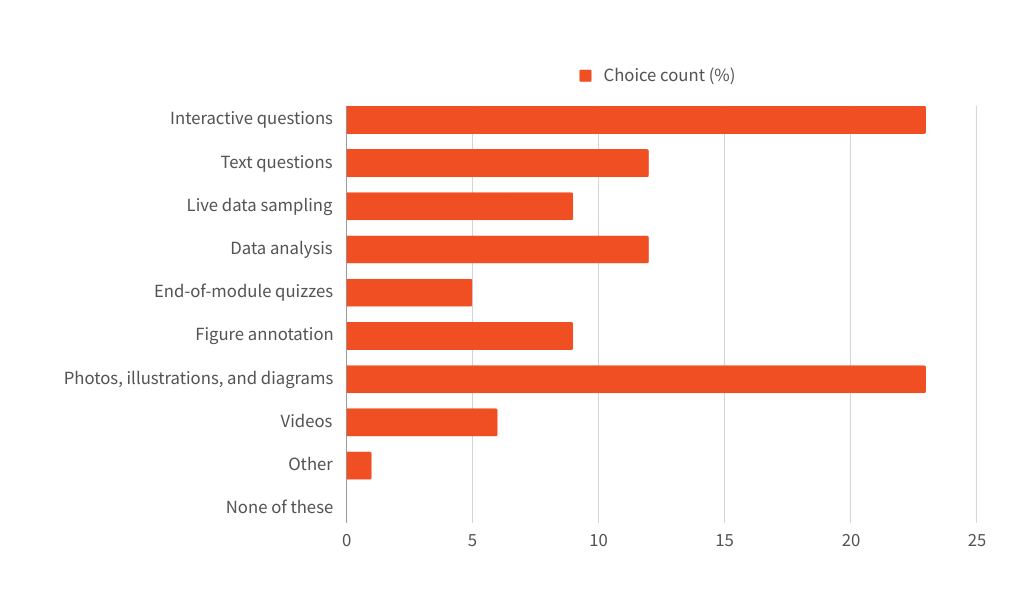There are 16 universities that form the University of North Carolina network, spread across the state.

Today, we find ourselves in the biology department at The University of North Carolina at Pembroke, a smaller public university found in a rural area.
First set up in 1887 as America’s only 4-year public institution established by American Indians for American Indians, UNC Pembroke is deeply connected to the Lumbee Tribe of North Carolina and now has ~8,300 students.
Although smaller than most, the university serves a diverse population, including nontraditional students.
In the biology department, professors Dr. Silvia Smith and Dr. Crystal Walline are focused on guiding the next generation of healthcare workers and scientists through the extensive world of anatomy and physiology.

Dr. Silvia E. Smith

Dr. Crystal Walline
Teaching as a “helping career”
Silvia and Crystal are both Professors of Biology, teaching AP1 and AP2 courses to students across majors. Although the majority of students complete anatomy and physiology courses as part of the medical biology program, other students come from pre-nursing, kinesiology, and exercise science tracks.
Crystal explains that, “nursing especially is a very common goal for many students; some would say half of our students are probably pre-nursing, and that's because the degree can be obtained relatively quickly and they can have a good living”.
Providing these students with a supportive and engaging lab experience is important for these educators, who enjoy the opportunity they have to interact with students in a tight-knit community.
As Silvia explains: “I like to work in a smaller university. I have worked in larger universities; students, especially undergraduates, don’t get a lot of attention, and here our undergraduates get more attention because our class sizes are fairly small”.
Both professors have a long history with teaching, starting in their teenage years. Helping people to learn is rewarding, whether they are nontraditional students or not!
Crystal explains her motivation when teaching A&P students: “I had a very good relationship with my advisor and he really mentored me and nurtured me. I was very appreciative of everything that he did for me, and I wanted to be able to do that for the next generation to give back”.

Students participate in a dissection activity in the lab at UNC Pembroke.
Watch Silvia and Crystal's recent presentation on how to instruct a diverse student population:
What defines a nontraditional student?
All students who attend your institution are unique and have different life experiences and motivations; in this sense, there is no such thing as a “traditional” student!
However, ‘nontraditional students’ have been commonly defined as older than those who enter college immediately after high school. Examples of nontraditional students as defined by age could be:
- An active professional in the workforce who is returning to study to study or change field
- A furloughed person who is training for a new career
- A parent who took time out to build their family and is taking the opportunity to study now that their children are older
- A veteran returning from military service
- A retiree pursuing a life-long interest or re-skilling for work
These students might be less common on campus, and feel insecure about standing out amongst a sea of 20-year olds. However, these students shouldn’t feel like they don’t belong.
They offer a unique perspective (you never know what they might have experienced before they chose to study) and may have skills that can help them succeed academically - for example, time management, communication, and confidence.
Coming to university later in life may also allow them to be more secure in their choice of study, giving them drive and purpose to get through the degree.
The National Center for Education Statistics (NCES) also lists other student characteristics that are seen as ‘nontraditional’. A student with any one of these traits might be seen as nontraditional:
- Delayed enrolment in higher education after high school
- Studies part-time
- Works full-time
- Is financially independent from parents
- Has dependents
- Is a single parent
In terms of paid work as it relates to an anatomy and physiology course at UNCP, many students studying anatomy and physiology with a career as a physician assistant in mind are required to work paid contact hours with patients, meaning that they are concurrently enrolled at UNCP and working as an EMT or paramedic.
Impacts on their study
Clearly, these additional responsibilities will impact the amount of time and energy students can devote to their studies.
At UNCP, aside from working, nontraditional anatomy and physiology students might be caring for extended relatives, looking after their children, or fulfilling military obligations.
As Crystal shares, there are “so many more competing priorities [compared to the average ‘traditional’ student]. Everything you can think of that could interfere with them being successful in school, we've heard.”

A father works while his infant son watches on.
The additional time commitments and stress of these factors has the potential to negatively impact students’ academic success - cutting into their study time, eroding their focus, preventing them from attending class, and potentially lowering their grades.
Science, Technology, Engineering, and Mathematics (STEM) courses already struggle with high dropout rates.
- <40% of students who start a STEM course graduate with a degree in their chosen field (Stevens Institute of Technology, 2023)
- In one study, 62% of A&P 1 students scored lower than a C and 36% of A&P 1 students dropped out of the course (Hopper, 2011)
Therefore, it’s even more important that we support nontraditional anatomy and physiology students so that they are retained and complete their course.
Teaching strategies to help nontraditional students
As anatomy and physiology educators, Silvia and Crystal support their students in the following ways:
1. Emphasize the importance of communication
“From the very beginning, I make it known that I have that interest in them succeeding, that I want to support them, that I'm not out to get them. I don't enjoy awarding bad grades at the end of the semester.”
Crystal makes it clear that her course is a supportive environment and that she is invested in her students’ success; students are encouraged to come forward if they are struggling. By being transparent about issues as they arise, students have the best opportunity to access accommodations:
“I tell our students, you have to remind us to check our assumptions, because if you're doing poorly in school, it can be easy for an educator to assume you're not trying. Whereas I've found, at least here, that the vast majority of the time that if there is a problem with their schoolwork…that the issue is not an education problem. It's a competing priority problem. So I just tell them, communicate with us because I can work with you on deadlines, I can work with you on being flexible for lab sessions.”
As part of this communication, you can add details of academic policies (for example, what will happen in the event of late assignments, missed lab sessions, or missed exams) to the class syllabus and to your learning management system (if you have one) for students to refer to.

Make sure that your office hour details are easily accessible too, and set expectations around email, for example:
- how long it might take to get a reply
- what kind of query warrants an email, and
- where to find answers to FAQs
Email is a useful tool for student-staff communication, but boundaries need to be set so that you can maintain work-life balance.
2. Keep other educators in the loop
Communication is not only important between students and faculty, but also between members of the faculty themselves. In a smaller department, this is easier, because educators are more likely to recognize students and know which classes they are in. Working together, educators are more likely to spot the warning signs when a student is struggling.
3. Be flexible with assignment deadlines
Although some students may try to take advantage of flexible deadlines without a valid reason, the benefits of this inclusive policy outweigh the risks.
Flexible deadlines are positively received by students, enhance their autonomy, enable them to iterate on and improve their work, and have been shown to reduce student stress (Hills & Kim, 2022).
Consider implementing a broad flexible deadline structure that allows students to submit work within a time ‘band’ without needing to request an extension at all, or provide a reason (Hills & Kim, 2022).
4. Be flexible when assigning students to lab sections (and/or provide example data online)
Assigning students to specific lab sessions is practical; it ensures that there will be sufficient resources available for the lab group and creates smaller class sizes. This reduces workload for Teaching Assistants when in the lab and increases the ratio of staff to students.
However, assigning students to a set lab period also comes at a cost. Nontraditional students have more time commitments and are more at risk of missing class due to extenuating circumstances. When this happens, if they are unable to make up the time, they lose out on valuable learning.
If letting absent students attend a missed lab in another session is impossible (for example, due to health and safety factors like lab occupancy rates), one option is to provide the lab and example data to students online. This can be done in Lt, so students can analyze the example data to test their hypotheses and answer questions, just as they would do in the lab.
5. Make students aware of other resources on campus
Modern universities and colleges typically provide on-campus and online support services for students, for example financial aid, counseling, and study help.
Sometimes it’s as simple as making the contact details for these services clear in the course syllabus and in the orientation session at the start of the semester.
In the case of UNC Pembroke, there is an early alert system that can flag when students are struggling academically (warning signs can be detected by technology, triggering an automatic support response), alongside a separate system that can be manually triggered by staff or students that helps with non-academic issues like homelessness, food insecurity, and mental health struggles.
“We have an early alert system…that goes to essentially a social worker who will reach out to that student and try to figure out what the university can do to support them and match them to resources. Sometimes they'll get them set up with counseling. Sometimes they need to get academic accommodations. Oftentimes it's a small amount of money. And generally there's a positive outcome from that.” - Crystal
Related: Talking Teaching: Pedagogy of care and the role of faculty in student mental well-being »
It’s important to be able to detect students who are struggling to help them stay in the course and succeed. This can be done quickly with educational software; for example, Lt’s Course Progress view allows you to see:
- Individual student’s progress in each lab, including if they have not started, are in progress, or have committed their work
- Number of students committed
- Average number of questions attempted
- Median time in lab
- Average grade per lab
If you identify a student who is regularly not completing work, you can copy their email address to follow up.
How else does technology support student learning?

1. Address short student attention spans with interactive content
With students absorbing information from TikTok, Instagram Reels, YouTube, and streaming services, it can be hard to cut through the noise and provide a varied experience that can engage them and consistently retain their attention.
Related: Five tips for teachers: How to activate your lessons! »
Providing hands-on lab exercises with interactive data, authentic hardware, images, diagrams, video, and interactive questions in your course can boost student engagement and ensure that the knowledge that is learned is applied.

Results of an AP1 student survey to the question, “What aspect(s) of the Lt platform (kuraCloud) experience helped you learn, if any?”
“Lt has made a great difference. They're more engaged before lab and they're more engaged during lab.” - Silvia
2. Centralize everything in your course in one place
You can reduce the workload for students (and the admin burden for yourself!) by making sure all of your course resources are in one place in the cloud. This means that students can revise for the lab, conduct their experiments, complete post-lab assessments, submit assignments, and be graded all in one platform.
“It was a no-brainer for me to switch six years ago because Lt was a centralized way of having the basic content, the clearly-stated goals, but also they can upload images that they take from labs, and they have exercises that require them to apply the knowledge. And so that facilitates the lab component. The interactive exercises are great…” - Silvia
3. Save money
When building your course, it pays (literally!) to consider how much your students will be spending to succeed. Traditional textbooks are expensive and lack the interactive features desired by modern students.
Diverse student populations that include nontraditional students are often under financial pressure, making it a smart move to consider subscription-based software tools rather than physical books.
“The cost to the student is a lot less than if we were to buy a paper lab book, and the experience is completely different.” - Silvia
4. Make your teaching more flexible
Using pre-made content lets you pick and choose what content, questions, and lab activities you’d like to share with your students. Crystal and Silvia use Lt for pre-lab activities to prepare students for the lab. This helps to avoid misconceptions and start labs with a strong foundation, as Silvia explains: “When I begin the lab I can either see what they haven’t completed or I ask them which part was difficult and they will tell me.”
Fully-editable labs mean that Crystal and Silvia can make adjustments to existing lessons as needed to fit their labs, which at 1 hour and 50 minutes are relatively short: “I do go through them and quickly edit them. Sometimes I'll take out something because I noticed that it took too long or make small adjustments.”
Making education more attainable for everyone
Ultimately, it’s important that we make an effort to support students from all backgrounds to achieve their potential. Like Crystal and Silvia, we hope you can implement some of these tips in your classroom!
Are you curious about how you can use Lt in your teaching? Try Lt today »

Dr. Silvia E. Smith
Dr. Silvia E. Smith,
Assistant Professor,
Weinstein Health Sciences Building,
The University of North Carolina at Pembroke.
Dr. Silvia Smith graduated with a PhD in biological anthropology from the University of Utah and serves as an Assistant Professor of Biology at the UNCP. Silvia is passionate about education and is affiliated with the University of Utah School of Medicine, Department of Internal Medicine, Pulmonary Division, in addition to her full-time position as an Assistant Professor of Biology at UNCP. She received and implemented a Grant for Excellence in Teaching and Learning in her anatomy and physiology course.

Dr. Crystal Walline
Dr. Crystal Walline,
Associate Professor,
Oxendine Science Building,
The University of North Carolina at Pembroke.
Dr. Crystal Walline graduated with a PhD in Medicinal Chemistry & Molecular Pharmacology from Purdue University and serves as an Associate Professor of Biology at the UNCP. Crystal is the co-founder of the Biomedical Laboratory at UNCP, which allows undergraduate students to undertake their own research. She is also a former member of the Enrollment Management Subcommittee and is chair of the Student Evaluation of Instruction committee.
Hills, M., & Peacock, K. (2022). Replacing Power with Flexible Structure: Implementing Flexible Deadlines to Improve Student Learning Experiences. Teaching & Learning Inquiry, 10. https://doi.org/10.20343/teachlearninqu.10.26
Hopper, M. (2011). Student Enrollment in a Supplement Course for Anatomy and Physiology Results in Improved Retention and Success. Journal of College Science Teaching, 40(3), 70–79. http://www.jstor.org/stable/42992862
Merriam-Webster. (n.d.). Nontraditional student. Merriam-Webster. https://www.merriam-webster.com/dictionary/nontraditional%20student
National Center for Education Statistics. (n.d.). Nontraditional Undergraduates / Definitions and Data. https://nces.ed.gov/pubs/web/97578e.asp
Stevens Institute of Technology. (n.d.). Why don't students stick with STEM degrees. Stevens Institute of Technology. http://www.stevens.edu/news/why-dont-students-stick-with-stem-degrees
